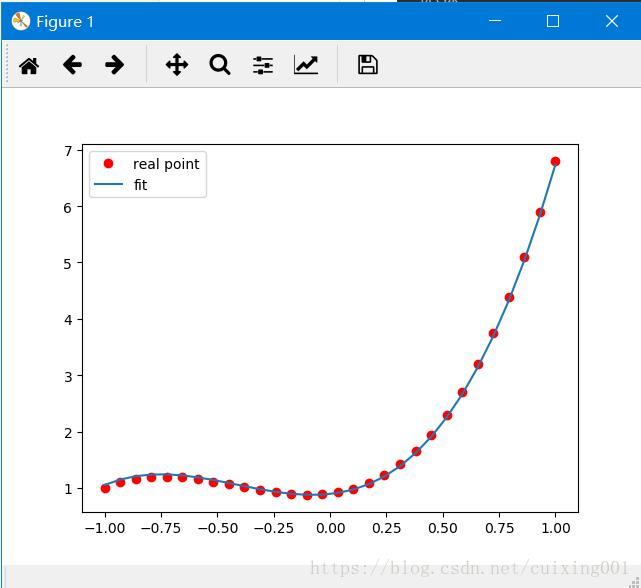首先给出真值多项式参考方程:

其对应参数形式为:

程序实现思路为 :根据方程1,给定一些列(假如默认是32个)(x,y)对应点集,及最小均方差为目标,求解最佳参数(w1,w2,w3,b)。
终止条件:小于1e-3退出循环。
编辑器:Spyder
# -*- coding: utf-8 -*-
"""
Created on Sun Sep 2 17:54:11 2018
@author: Cuixingxing
"""
import numpy as np
import matplotlib.pyplot as plt
import torch
from torch.autograd import Variable
import torch.nn as nn
import torch.optim as optim
#%% w和b系数矩阵,注意返回的是N*3大小矩阵
def make_features(x):
x = x.unsqueeze(1)
return torch.cat([x ** i for i in range(1,4)] , 1)
#%% 要拟合的多项式真值系数w和b
W_target = torch.FloatTensor([0.5,3,2.4]).unsqueeze(1)
b_target = torch.FloatTensor([0.9])
def f(x):
return x.mm(W_target)+b_target[0]
def get_batch(batch_size=32):
random = torch.randn(batch_size)
x = make_features(random)
'''Compute the actual results'''
y = f(x)
if torch.cuda.is_available():
return Variable(x).cuda(), Variable(y).cuda()
else:
return Variable(x), Variable(y)
class poly_model(nn.Module):
def __init__(self):
super(poly_model, self).__init__()
self.poly = nn.Linear(3,1)
def forward(self, x):
out = self.poly(x)
return out
if torch.cuda.is_available():
model = poly_model().cuda()
else:
model = poly_model()
criterion = nn.MSELoss()
optimizer = optim.SGD(model.parameters(), lr = 1e-3)
epoch = 0
while True:
batch_x,batch_y = get_batch()
output = model(batch_x)
loss = criterion(output,batch_y)
print_loss = loss.item()
optimizer.zero_grad()
loss.backward()
print("loss:%.5f\n" % loss)
optimizer.step()
epoch+=1
if print_loss < 1e-3:
break
#%% 绘制真值和拟合结果曲线
x = np.linspace(-1,1,30)
x_sample = torch.from_numpy(x)
x_sample = x_sample.unsqueeze(1)
x_sample = torch.cat([x_sample ** i for i in range(1,4)] , 1)
x_sample = x_sample.float()
y_actural = f(x_sample)
tt = x_sample.cuda()
y_predict = model(tt)
plt.plot(x,y_actural.numpy(),'ro',x,y_predict.data.cpu().numpy())
plt.legend(['real point','fit'])
plt.show()

Reference:
《深度学习入门之Pytorch》-廖星宇 编著





 本文介绍了一个使用PyTorch实现的多项式拟合案例,通过定义多项式的真值系数,生成数据样本,并利用神经网络模型来逼近这个多项式函数。该过程包括模型训练、损失计算与参数更新等步骤。
本文介绍了一个使用PyTorch实现的多项式拟合案例,通过定义多项式的真值系数,生成数据样本,并利用神经网络模型来逼近这个多项式函数。该过程包括模型训练、损失计算与参数更新等步骤。
















 6423
6423

 被折叠的 条评论
为什么被折叠?
被折叠的 条评论
为什么被折叠?








